- Home
- Views On News
- Feb 3, 2023 - Say NO to High PE Stocks like Adani and Look at These 3 Undervalued Stocks in 2023
Say NO to High PE Stocks like Adani and Look at These 3 Undervalued Stocks in 2023

Rahul went to the market to buy seeds for a rose plant. Walking around the market, he noticed many stalls selling all kinds of seeds.
As he went from one stall to another, Rahul quickly established that most sellers are willing to sell their rose seeds around Rs 100 per packet.
Just then, Rahul noticed a shop at the other end packed with people buying rose seeds. Surprisingly, the seeds in that shop are much smaller but are being sold for Rs 1,000 per packet.
Intrigued, Rahul asks why they are priced so much higher and yet still in demand...
The shopkeeper explained that these seeds grow much faster than regular seeds and who knows, one might just get multiple rose plants from one seed!
Excited, Rahul bought a packet of these high growth seeds, went home, and planted them.
Months pass by and a small shoot emerges. Over the next few years, the shoot grew bigger and bigger, but alas no rose ever sprouted.
You are probably wondering why we are talking about rose plants?
The story could draw a parallel to a similar episode in the Indian stock market. How, you wonder?
Here goes...
The seed could be the stock of a company. The price you pay for that high growth seed is the price you pay (or overpay) for a stock. The shoot that emerges could be the marketcap which gets bigger and bigger...
And the rose that never seems to emerge could be the profit that the company rarely makes and isn't justified by its valuations!
PE: Paying Extra?
In recent days, everyone and their grandma has been shouting from the rooftops about the risks of buying high PE (Price to Earnings Ratio) stocks.
But why is the market suddenly waking up to this long-known fact?
Well, maybe it has something to do with a six-day marketcap erosion of over Rs 10 trillion (tn).
That's what the Adani group stocks have lost ever since the Hindenburg report was published on 24 January.
It accused the Adani group of fraud and market manipulation. Fresh blows to the Adani group keep on adding up and the stocks have once again witnessed a steep selloff today.
And it's not just the Adani group that has suffered ever since. The BSE Sensex has also lost over 2.5% as this is the latest in a string of negative news coming in from across the world for equity investors.
The Sensex gained just 4.4% in 2022. This was in stark contrast to the 3 years prior where it gained on an average 17.3% year on year.
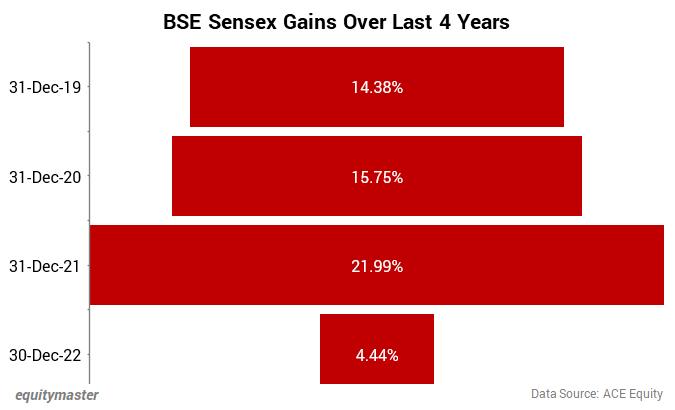
But for equity investors who were hopeful that in 2023, the Sensex would resume its bull run, unfortunately, the new year has not got off to a good start.
The war in Ukraine has got only worse with the US and Germany agreeing to supply the world's deadliest tanks to Ukraine, a move that Russian officials have condemned as a "blatant provocation."
Recession fears have emerged stronger since the spread between three-month rates and 10-year yields on US treasury bonds dropped to nearly -1% last month from as high as 2.3% in May 2022. This spread has gone negative only 8 times in the past 50 years and all 8 times have been followed by recessions.
And although some people believe that India is the only bright spot in the world which will be least affected by global recession, this remains to be seen.
The International Monetary Fund (IMF) is already expecting some slowdown in the Indian economy in FY 2023, projecting growth to reduce to 6.1% from 6.8% during the current fiscal ending in March 2023.
And then of course, investors have been hit hard with the market rout due to negative news flowing in for India's richest man and his group companies.
In such an environment, how does an equity investor pick stocks in 2023?
One thing is for sure... you definitely avoid high PE stocks!
For instance, even after the massive rout in Adani group's stock valuations, the PE ratios are still insanely high.
| Company | PE Ratio |
|---|---|
| Adani Enterprises | 147.7 |
| Adani Power | 7.2 |
| Adani Ports & Special Economic Zone | 20.5 |
| Adani Transmission | 174.1 |
| Adani Green Energy | 277.7 |
| Adani Total Gas | 352.7 |
| Adani Wilmar | 75.6 |
So then, does one simply look out for low PE stocks?
Price Earnings (P/E) ratio is one of the most popular ways of valuing a stock. The thumb rule is that a low P/E ratio is a sign of undervaluation while a high P/E ratio is a sign of overvaluation.
But such an approach of purely using P/E Ratio to value a stock is unfortunately not enough.
First, a P/E ratio depends on the industry that a company belongs to. Some industries have higher ratios merely because those are in demand.
If you think about it, all of Adani's companies, be it gas, green energy, ports, power, etc are in industries which are in high demand or expected to be in the future.
And that is what the group's supporters believed justified higher PE's. But as seen time and again, investors tend to go overboard willing to buy such stocks even as prices move higher and higher.
Well, did the growth in these stocks really keep up with the valuations? Obviously, not.
Let's take the example of Adani's flagship company, Adani Enterprises.
In the simplest of terms, a P/E ratio of 307 would indicate that the present market value of Adani Enterprises is equivalent to 307 times its annual earnings.
Hypothetically, buying the company's shares would get your initial investment back in 307 years, through any earnings of the company, assuming that the company never grows in the future.
Now, as an investor, you aren't going to put in your hard-earned money in a stock that takes over 300 years to just get your initial investment back.
By now it must be clear... The key here is growth, growth, and more growth.
But of course, how much a company will grow or is expected to grow is subject to the market's fancy.
Sadly, as seen with the Adani fiasco, markets often tend to get over exuberant with this "growth" picture and it usually doesn't end well for investors.
But what if there was a way to consider the price to earnings while factoring in its growth potential based on actual data?
Fortunately, there is and it's called the PEG Ratio (Price/Earnings-to-Growth).
Using the PEG Ratio to Select Stocks
The price/earnings-to-growth ratio, or the PEG ratio, is a metric that helps investors value a stock by considering a company's market price, its earnings and its future growth prospects.
As growth is a key component of a stock's expected return, the inclusion of the growth rate gives the PEG an advantage over the most commonly used alternatives.
To get the PEG, you first divide a stock's price by its earnings per share (EPS), just as you would to get the P/E ratio.
Once you have the P/E ratio, you divide that by the expected earnings-per-share growth rate over a period of time.
| PEG Ratio = | P/E ratio |
| ----------------- | |
| Expected Annual EPS growth rate |
Growth companies tend to have higher P/E ratios as investors are willing to pay more for potential growth. But how much should an investor be willing to pay for growth?
A "growth at any cost" approach can result in paying too much even for a great company. The PEG ratio can help an investor put a price on a company's rate of growth.
The PEG ratio also allows investors to see how cheap a stock is relative to its growth rate. All things being equal, a lower PEG ratio is better.
According to famous fund manager, Peter Lynch, the rate of growth should approximate the price of the stock, hence claiming that 1 is a fair PEG ratio.
The price-to-earnings ratio of a stock can generally be found in any analyst reports or from a company that has given its own guidance and projections.
Like any other valuation metrics, it's a good idea for investors to use the PEG ratio along with other tools and also consider the balance sheet, debt burden, and cash flow, which aren't reflected in the PEG ratio.
With that being clear, let us look at 3 large-cap stocks with the best PEG ratio (least price earnings to growth ratio) that one can add to their watchlist in 2023.
Please note, the source of data (PEG ratios) for these companies is from the ET Wealth edition dated 30 January 2023.
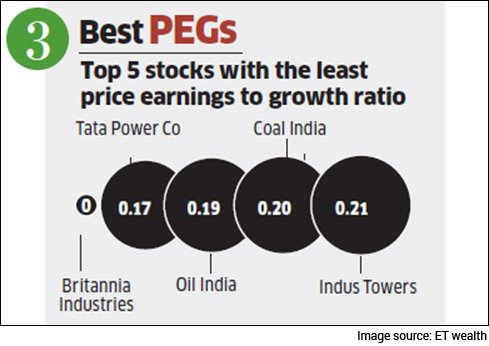
#1 Britannia Industries Ltd
Britannia is one of the leading food companies and the largest biscuit manufacturer in India. The company has a presence in more than 60 countries across the globe.
Britannia's product portfolio includes biscuits, bread, cakes, rusk, and dairy products including cheese, beverages, milk, and yoghurt.
Over the last five years, the company has consistently reported higher revenues and the markets expect this momentum to continue going forward.
The company has continued to broaden the gap as far as market share is concerned and gained market share for ten consecutive years.
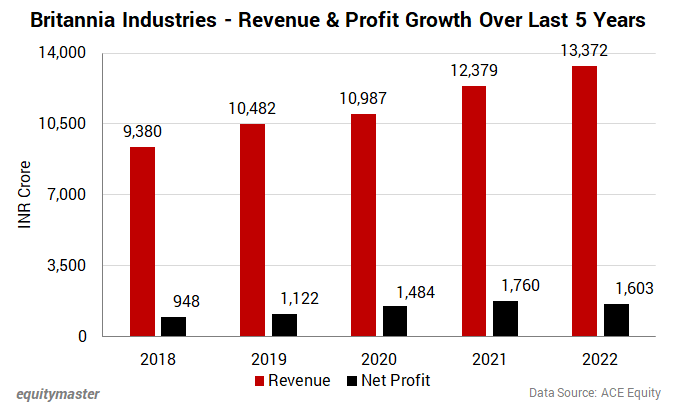
Britannia reported consolidated net profit of Rs 9.3 bn for the December 2022 quarter, up over 150% when compared with the previous-year period.The company's consolidated sales for the third quarter grew 16% year-on-year to Rs 41 bn, while operating profit rose 55% year-on-year to Rs 7.6 bn.The company is set to continue achieving volume growth above the industry's growth in the core biscuit category with its deepening penetration in the rural market.
Britannia, which announced a joint-venture with French cheesemaker Bel Group in December 2022, aims to scale up its packaged cheese business by 5x to about Rs 12.5 billion (bn) over the next five years.
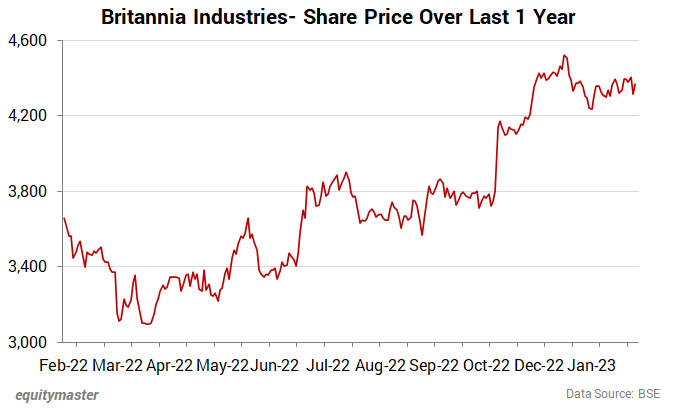
The share price of the company is up 23% over the last 12 months with a yearly high of Rs 4,596 and low of Rs 3,050.
At current market prices, the PEG ratio of the company is 0.0 which indicates that the stock is undervalued as per this metric.
#2 Tata Power Ltd
Tata Power, India's largest integrated power company is betting big on green energy.
The company is already India's largest player in the renewables space in terms of its manufacturing capacity and strength of its EPC contracts.
And it aims to double its total capacity from 13.5 gigawatts (GW) in 2022 to over 30 GW by 2027. The company plans to invest over Rs 750 bn in the next five years.
This will increase its renewable energy capacity from 32% to 60% by 2027 and 80% by 2030.
The company has plans to install EV chargers all over India, with an expected 100,000 charging stations over the next 10 years.
To expand its solar engineering procurement and construction (EPC) business, it is setting up a 4-gigawatt (GW) plant with a capex of Rs 30 bn in Tamil Nadu.
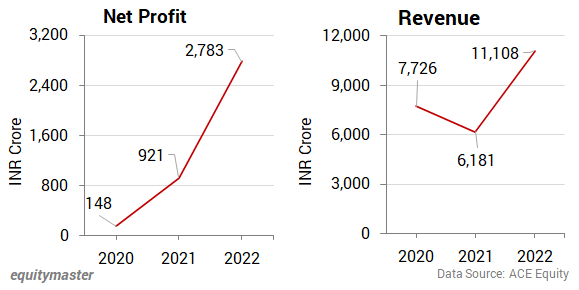
The company's revenue jumped 44% from Rs 77.2 bn in 2020 to Rs 111 bn for the financial year ended 31 March 2022.
Net Profit zoomed 1,779% to Rs 27.8 bn from Rs 1.4 bn for the same period.
Going forward, its expansion plans will drive its revenue and profit.
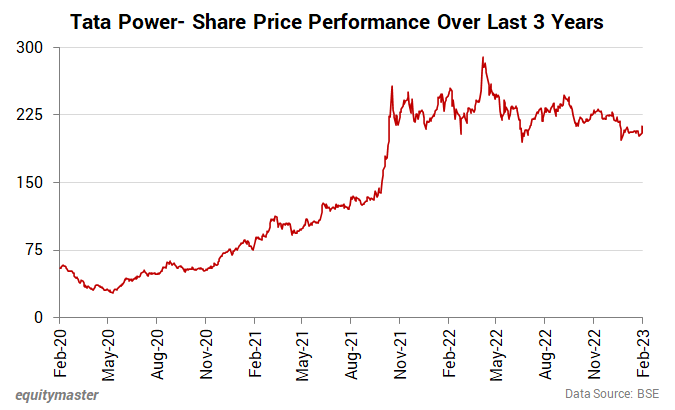
Shares of Tata Power delivered negative returns of 6% during 2022 and remained in consolidation mode after rallying nearly 300% over the previous two years.
However, the rising interest rate scenario along with highly volatile markets kept investors on the side lines of the Tata Power counter last year.
Tata Power has set an ambitious target to triple its revenue and quadruple its PAT by FY2027.At the current market price, the PEG ratio of Tata Power stands at 0.17 making it one of the least expensive price to earnings growth stocks in the largecap space.
#3 Indus Towers Ltd
Indus Towers is India's largest mobile tower installation company with over 189,392 towers and 339,435 co-locations (as on 30th September 2022) and a nationwide presence covering all 22 telecom circles.
Indus Towers was formed by the merger of Bharti Infratel and Indus Towers making it one of the largest telecom tower companies in the world.
In India, three out of every five calls made are through an Indus site.
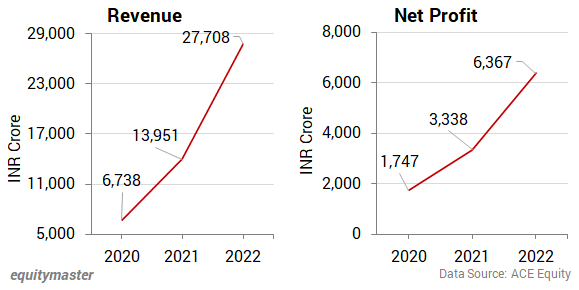
The company's revenue has surged over the last 3 years from Rs 67 bn in 2020 to Rs 277 bn reported for the financial year ended 31 March 2022.
Profits have also kept up, zooming 265% from Rs 17.4 bn to Rs 63.6 bn over the same period.
However, the company has reported weak results for three consecutive quarters.
In the June and September 2022 quarters, Indus Towers reported a 66% and 44% fall in net profit respectively on account of receivables due to Indus Towers from one of its major customers.
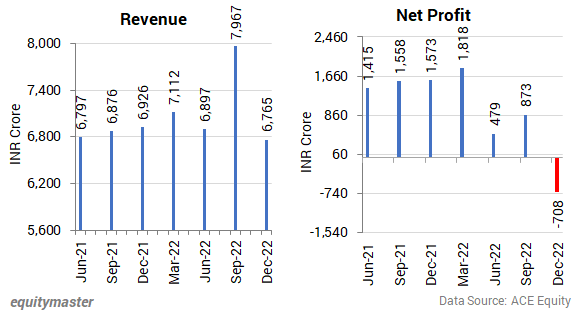
In December 2022, Indus Towers reported a loss to the tune of Rs 7.1 bn after the company made Rs 23 bn worth provisions towards doubtful debt.
The company had earlier made provisions of Rs 17.7 bn in the September quarter and Rs 12.3 bn in the June quarter.
Going forward, growing 4G volumes and emerging technologies such as 5G, artificial intelligence, robotics, and the internet of things, will provide an opportunity for the company to expand its offerings.
The company also sees the tower network as a big fit for EV infrastructure, and even advertising in the foreseeable future.
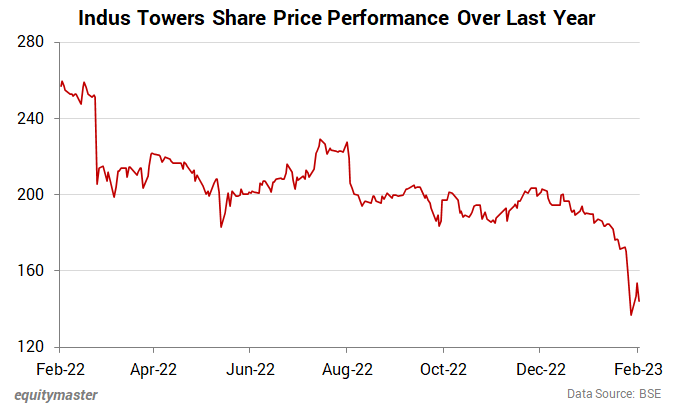
Over the last year, Indus Towers shares are down 44% which has resulted in the PEG ratio to be at 0.21 at current market price.
And that's it...
These are the three companies in the largecap space with very low Price/Earnings to Growth ratios. The PEG allows investors to evaluate stocks in a better way.
However, it is always wise to use the PEG ratio along with other ratios and indicators to create an investing strategy.
You can also check out the video version of this editorial on Equitymaster's YouTube channel.
Safe Stocks to Ride India's Lithium Megatrend
Lithium is the new oil. It is the key component of electric batteries.
There is a huge demand for electric batteries coming from the EV industry, large data centres, telecom companies, railways, power grid companies, and many other places.
So, in the coming years and decades, we could possibly see a sharp rally in the stocks of electric battery making companies.
If you're an investor, then you simply cannot ignore this opportunity.
Details of our SEBI Research Analyst registration are mentioned on our website - www.equitymaster.comDisclaimer: This article is for information purposes only. It is not a stock recommendation and should not be treated as such. Learn more about our recommendation services here...

Yazad Pavri
Cool Dad, Biker Boy, Terrible Dancer, Financial writer
I am a Batman fan who also does some financial writing in that order. Traded in my first stock in my pre-teen years, got an IIM tag if that matters, spent 15 years running my own NBFC and now here I am... Writing is my passion. Also, other than writing, I'm completely unemployable!


Equitymaster requests your view! Post a comment on "Say NO to High PE Stocks like Adani and Look at These 3 Undervalued Stocks in 2023". Click here!
Comments are moderated by Equitymaster, in accordance with the Terms of Use, and may not appear
on this article until they have been reviewed and deemed appropriate for posting.
In the meantime, you may want to share this article with your friends!